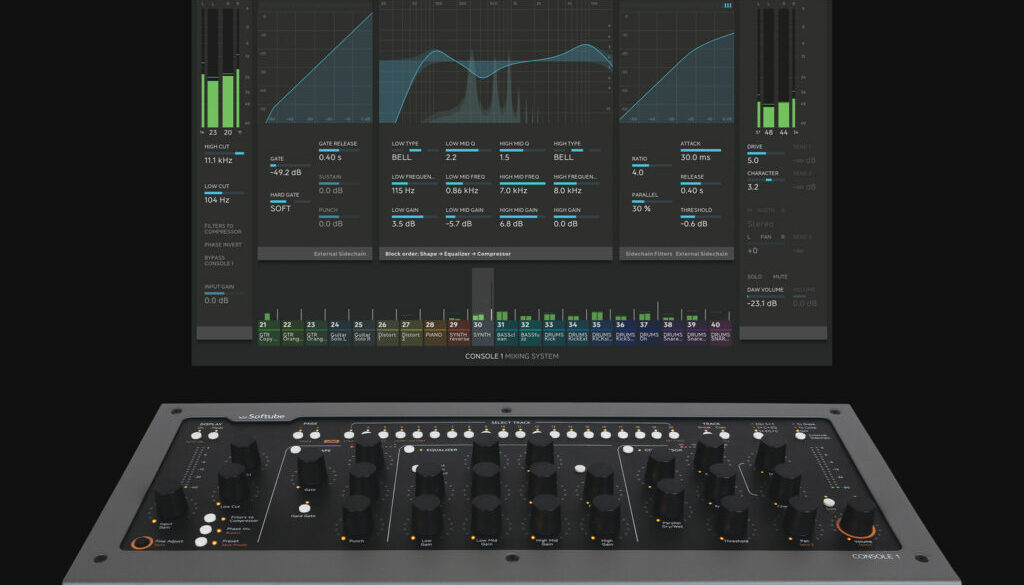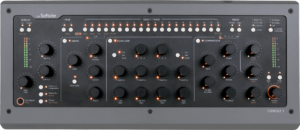Why I Went Back to Softube Console 1

I finally get what is so special about Softube Console 1.
I’m a constant tinkerer when it comes to my mixing process and the tools I use. I think it comes from this never-ending feeling that my mixes could sound better, like there might be just one missing ingredient that pushes my work over the edge into world class, pro territory.
But I’m also pretty hard on myself about getting songs done and not getting lost in the search for better tools. I generally keep up on new products and what’s going on in the audio production market, but I try not to let my research become more important than actually making music.
It’s hard sometimes! We are constantly being bombarded with ads and sales and promos, and it feels like amazing new gear is coming out every month! And every product promises to make you into the next CLA or Bob Clearmountain (looking at you Steven Slate). Hot take: they won’t. Okay, most won’t. I’d be lying if I said there weren’t a couple of hardware pieces or plugins that legitimately bump your mixes up a class or two.
Every now and then, though, I get restless and let myself dive into the market to see if I think anything will help me push the quality of my work just that little bit higher.
One of these times happened four or five years ago, when I caught wind of what Softube was doing with their hardware plugin controller, Console 1. I’d used Softube plugins and knew they were quality, and I liked the idea of getting away from the mouse for mixing.
I felt like maybe I was spending too much time looking to make my mix decisions, and not enough time listening. And I felt my mixes were probably suffering for it. I liked that Console 1 allowed you to switch console models and that all of the essential channel processing was laid out right there in physical knobs that you could turn – compression, eq, gate. The design made sense to me, so I took the plunge and shelled out.

When it arrived, I put it through its paces – mainly to see if I could get better sound with it. That’s my approach with everything I try out; it’s kind of a champion/challenger thing. At any point in time, I’m currently using what I think sounds best. So if I’m going to introduce something new, it’s got to beat the champ and sound better. And better enough to justify the expense or the time and energy required to adapt to a new workflow (or both).
So I shot out Console 1’s default SSL 4000 model against the plugins I would normally use on various tracks. And it sounded good. Really good, in fact! In some instances it was right there with what I had been using. In some cases it was even a little better, others not quite as good.
But even after auditioning other console models offered by Softube, I just didn’t feel it was better enough to justify the cost, and it felt a little limiting. What if I wanted to use other compressors or eqs? I could, but it sort of negated the benefits of the hardware-only approach, because then I’d have to go back to the mouse and dink around in my DAW again.
Back it went to the store from whence it came.
In the time since then, I’ve done a lot of mixing. And a lot of learning. Now, when I’m looking for a compressor on a track, I don’t audition every dynamics plugin I own to find the one that sounds the absolute best. I generally know what might work on what source so I end up trying maybe a first call plugin and a backup.
I also don’t approach mixing with as much of a focus on individual tracks. I tend to listen to how things work together rather than in isolation.
I’m not hung up on what the latest, coolest plugin is anymore, either.
And I want to mix faster. I want to hear the magic of the mix happening in a smooth flow, rather than in little segments punctuated by periods of auditioning plugins or trying every possible way to squeeze the most out of a track.
I also want my mix to feel more cohesive. One of the great things about the amazing variety of plugins today is that there are so many different flavors. Want to mix with an SSL on one track and a Neve on the next and and API on the next? Easy! But your tracks won’t always sound like they belong in the same song, if you know what I mean.
And that’s why, after writing off Console 1 as not being a good fit for me years ago, I bought it again – which I’ve never done before! And I gotta say.. this time around, I’m loving it.
I like that mixing involves more tactile interaction. There is something about turning knobs and hearing things happen. It sounds silly, but it’s totally true. It’s not the same as mousing around in a mix. I like that I can load up a console at the start of a mix, pull up Console 1 on screen and from there on out, just use buttons and knobs to flip through tracks and dial them in. It feels better.
I’m also digging that Console 1 now allows me to switch individual components to different models or even other UAD plugins that I own. This was kind of big for me because I’m heavily invested in the UAD platform, and many of my go-to plugs are made by them.
Now, I can sit down with a brand new mix and have something dialed up and sounding good in an hour or two. Just flying away and getting lost in the flow. And that’s just plain fun. Where I am in my music pursuits these days, I don’t do anything unless doing it is fun or makes me happy in some way.
Of course there are plugins I use outside of Console 1, but I generally set them up as part of my template now and only need to tweak them occasionally. The rest of the time is spent mixing with my ears and hands.
Looking back, I realize that I didn’t give it a fair shake when I first bought it. Are there plugins that will beat it on an individual track? Yeah, of course – depending on the source of course. And the modeled consoles in C1 are subtle. They’re not all up in your face with their signature sound like some are. But the magic Console 1’s sound is cumulative. It builds up over tracks, until your overall mix is suddenly sounding better than you thought it could, and faster.
So I might be able to make a snare track crack harder with another setup, but I’ll be my whole mix sounds better when I use Console 1. Partly because the software sounds really, really good – as Softube’s plugins always have been – but partly because I’m able to get out of my head when I’m mixing and just ride the flow of the music I’m shaping.
I think at the end of the day I wanted to try C1 again because I liked the idea of it so much. It clicked with how I work, or rather how I wished I could work. Ultimately it took me becoming more seasoned as a mixer to appreciate what it brings to the table and how I could use it to make me better at what I love doing so much.
And now I get it.
** I have no affiliation with Softube and pay for all my own gear (unfortunately). **
January 27, 2023 @ 6:21 am
I like the hardware controller for console 1, but I honestly don’t love the plugin, at least by default. In order to combat aliasing they’ve got what looks like a brick wall LPF, which is fine, but it’s also not linear phase. Good for latency and CPU, but when you stack it across multiple tracks I do notice something weird in the high end, at least for tracks that have correlation in the high frequencies (drum tracks from a real drum kit for instance) Running it at 96k fixes this behavior. The plugin will still alias with the drive cranked but I don’t do that very often.
Ultimately I find myself using the plugin as a glorified gain staging plugin for getting balances right and not doing much processing with it. Sometimes the EQ or the compressor is perfectly fine for what I want, but more often I have other tools I like better. For general mix balancing I do like it so much more than a mouse. I could have just bought any control surface but at least the hardware is nice.
I know the post is almost a year old now, so I’m curious if you still find yourself liking it as much as when you posted this?
March 29, 2023 @ 9:23 pm
Hey Michael, thanks for sharing your experience and sharp observations. Yes, I’m still enjoying Console 1. I haven’t been doing as much heavy mixing lately, but when I do I find I’m able to dial in mixes so much faster than I used to when I was using individual plugins. I still audition different console strips, eq, compressors, etc. within Console 1, but it’s very quick process. And I still use a few external plugins, mostly Pro-Q for finer adjustments, or saturation plugins – though I’m getting most of my saturation from hardware transformers now. Thanks again for your thoughts!